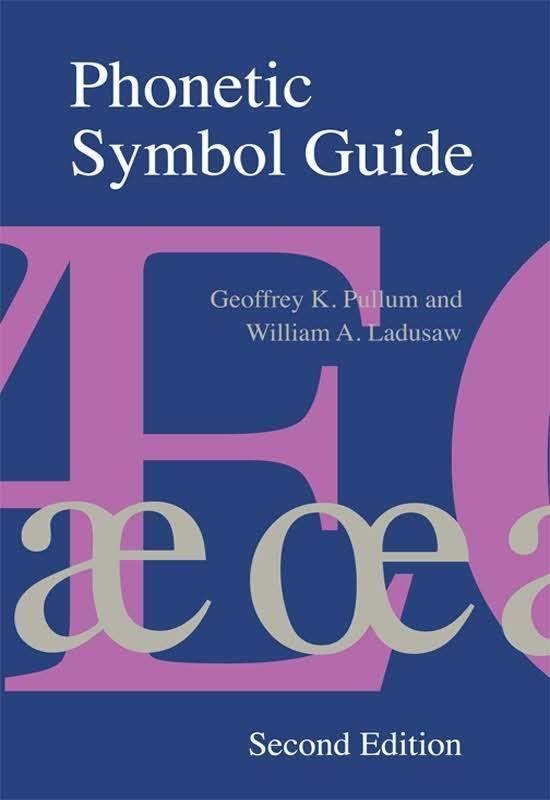The Phonetic Symbol Guide is a book by Geoffrey Pullum and William Ladusaw that explains the histories and uses of symbols used in various phonetic transcription conventions. It was published in 1986, with a second edition in 1996, by the University of Chicago Press. Symbols include letters and diacritics of the International Phonetic Alphabet and Americanist phonetic notation, though not of the Uralic Phonetic Alphabet. The Guide was consulted by the International Phonetic Association when they established names and numerical codes for the International Phonetic Alphabet and was the basis for the characters of the TIPA set of phonetic fonts.
The following are not supported by Unicode as of version 8.0, though all are supported by TIPA (see there for characters that are not clear below):
The Beach click letters ⨎ for the palatal clicks and curly-tail ʇ ʖ ʗ ⨎ for the nasal clicks of Khoekhoe. Used by other linguists for e.g. Sandawe.Some typewriter substitutions made by overstriking a Latin letter with a virgule:
⟨b̸⟩, for a voiced bilabial fricative⟨d̸ ⟩, for a voiced dental fricative⟨u̸ ⟩, for [ʉ]⟨w̸ ⟩, used for Nahua [w̥]Some of the symbols are idiosyncratic proposals by well-known scholars that never caught on:
triple virgule, ⦀ (a close-kerned ///), used in a passing mention of retroflex clicks in the Cole article "Bushman Languages" in the 1966 Encyclopedia Britannica (4: 469). The symbol was removed from later editions.a right-tail hooktop h (fusion of ⟨ɦ⟩ and ⟨ɳ ⟩: approx. ɦɳ), found for the velar fricative in the Germanic 'fortis' voiceless spirant series f þ ɦɳ, contrasting with the voiced series ƀ ð ᵹ and the Indo-European 'lenis' spirants ɸ θ χ in Prokosch (1939) A Comparative Germanic Grammar. (See esp. p. 51.) Prokosch describes the symbol as a "modified h, since h is the usual spelling in all Germanic languages" (p. 83), though other authors simply write these sounds f þ h.hooktop j, an Americanist variant of ⟨ʄ⟩ in Smalley (1963) Manual of Articulatory Phonetics. Unlike ⟨ʄ⟩, in the Smalley letter the hook connects to the dot of the jay and so is detached from the body of the letter.superscript spacing diacritic ⟨←⟩, used to indicate clicks in Smalley (1963) the way ⟨!⟩ is used in KirshenbaumSeveral symbols may be variants of characters that are supported by Unicode:
t and d with a horizontal hook to the left, used by Daniel Jones before ⟨ʈ⟩ and ⟨ɖ ⟩ were adopted by the IPA in 1923; might be considered allographs of those lettersp with a tail facing left ( ɋ), an allograph in Doke of ⟨ƍ⟩ (turned delta δ), which the Guide describes as o with a reversed ogonek (ǫ)Several symbols were only mentioned in the 1949 Principles of the International Phonetic Notation as recent suggestions for further improvement and were never adopted:
h-m ligature, approx. hm or ɰ (turned ɰ) for [m̥]⟨↊⟩ turned 2, 2 (looks like ح) for [ħ]⟨↋⟩ turned 3, 3 (looks like ع) for [ʕ]turned small capital K, K, for a generic consonant; now ⟨C⟩ is generally usedturned small capital U, U, for a generic vowel; now ⟨V⟩ is generally usedMany of the symbols were proposed by George Trager to improve the Bloch & Trager system of vowel transcription and other conventions of Americanist notation, but were never adopted:
inverted (turned) small capital A to replace æ̇small capital Ꜵ ligature (looks like an A-D ligature) to replace ɒ̈small capital Δ to replace ᴇ̈barred ɔ, ꞓ (turned ꞓ) to replace ɔ̇inverted (turned) ω, ω, to replace ω̇⟨ꭥ̶⟩, to replace ꭥ̇u with a bar on the left leg, u- , to replace u̇gamma with a palatal tail turning left, approx. γ̡, to replace γ̯gamma with a retroflex tail turning right, approx. γ̢, to replace γ̣a fusion of ᴛ + n (n with the arm of ᴛ to the left, approx. ᴛ n ) for the dental nasal [n̯]a reversed small capital L, ʟ (turned ᴦ), for a labial lateral approximant; this is not a distinctive sound and the symbol was never used.
